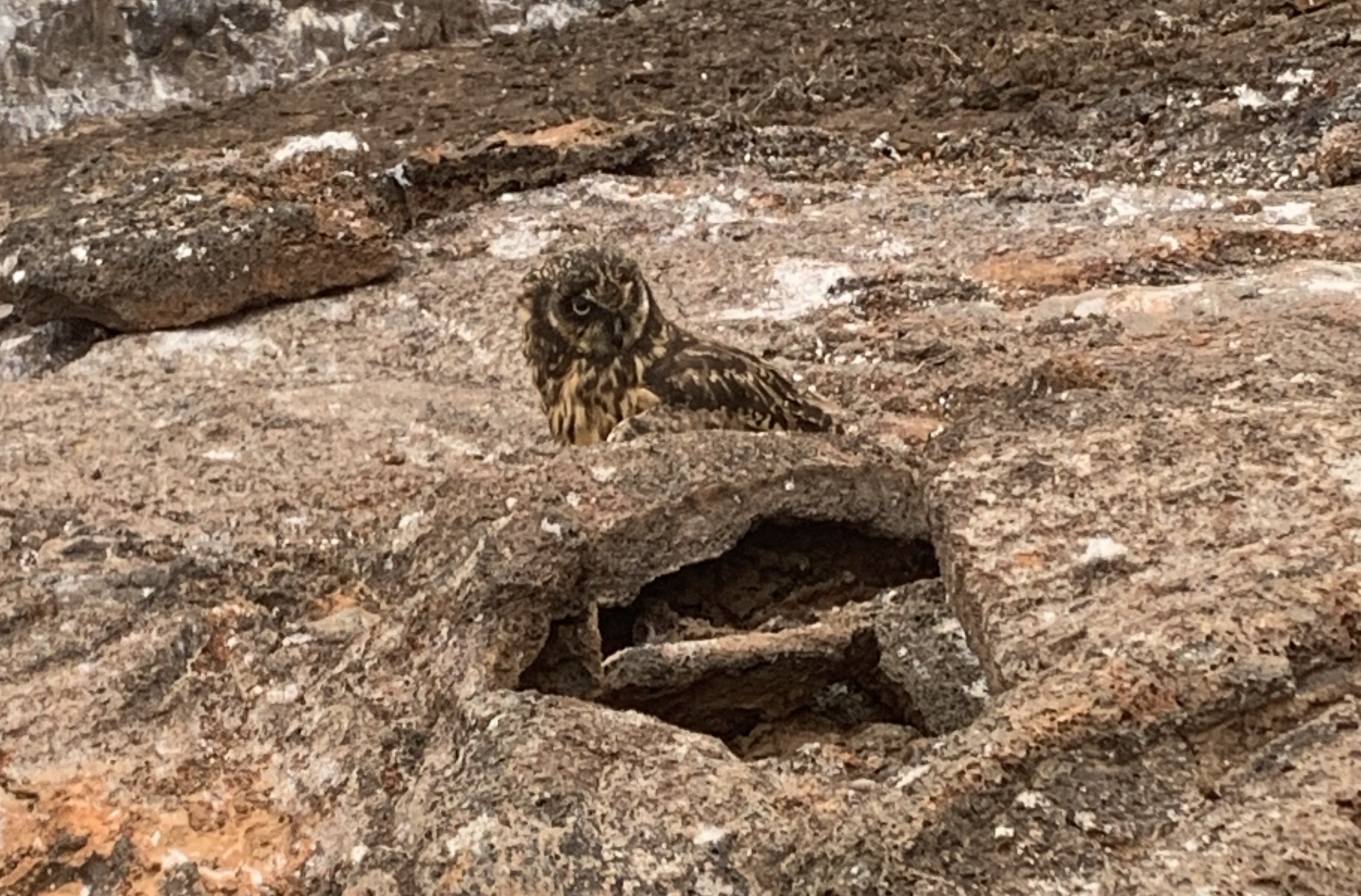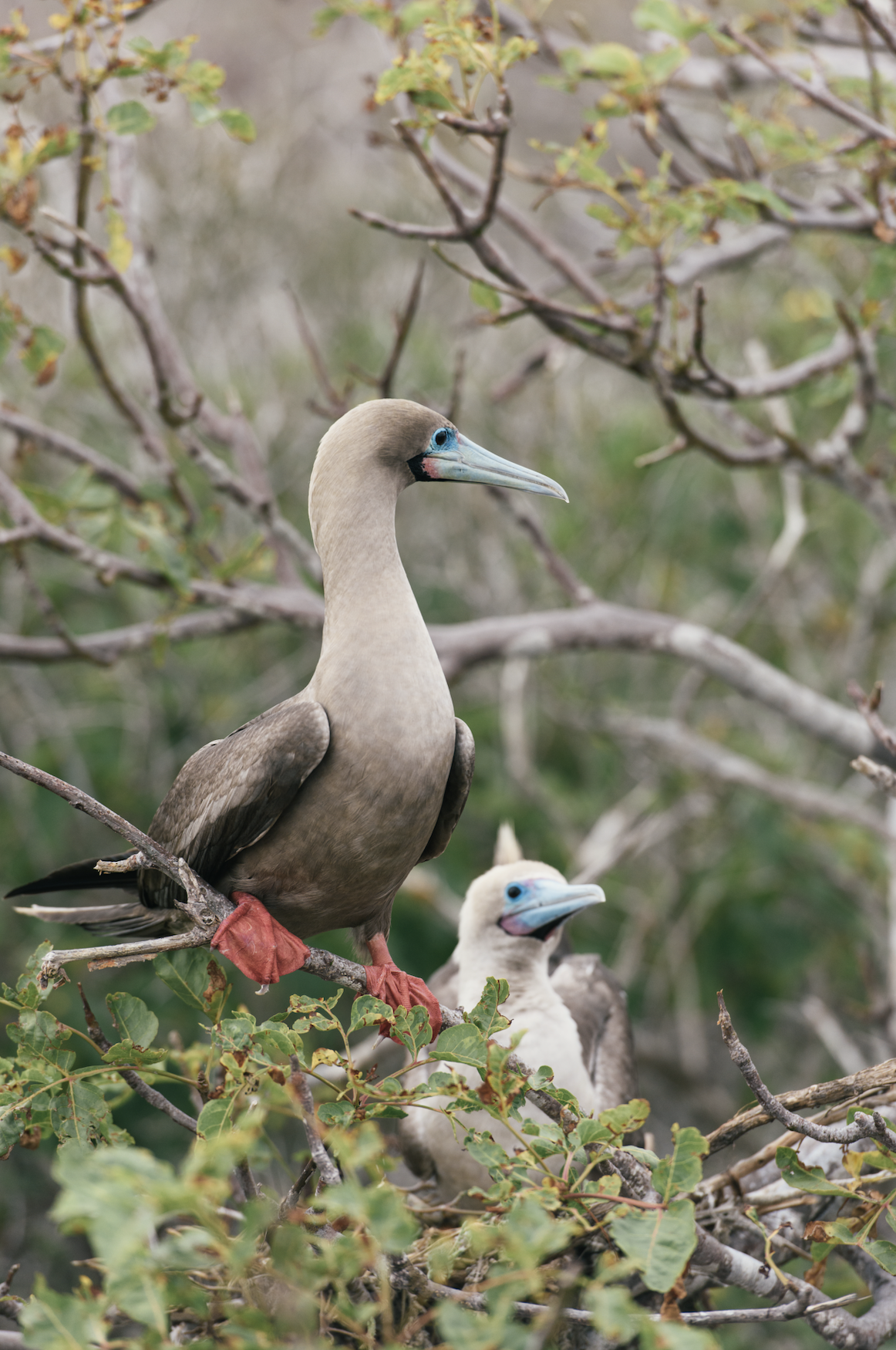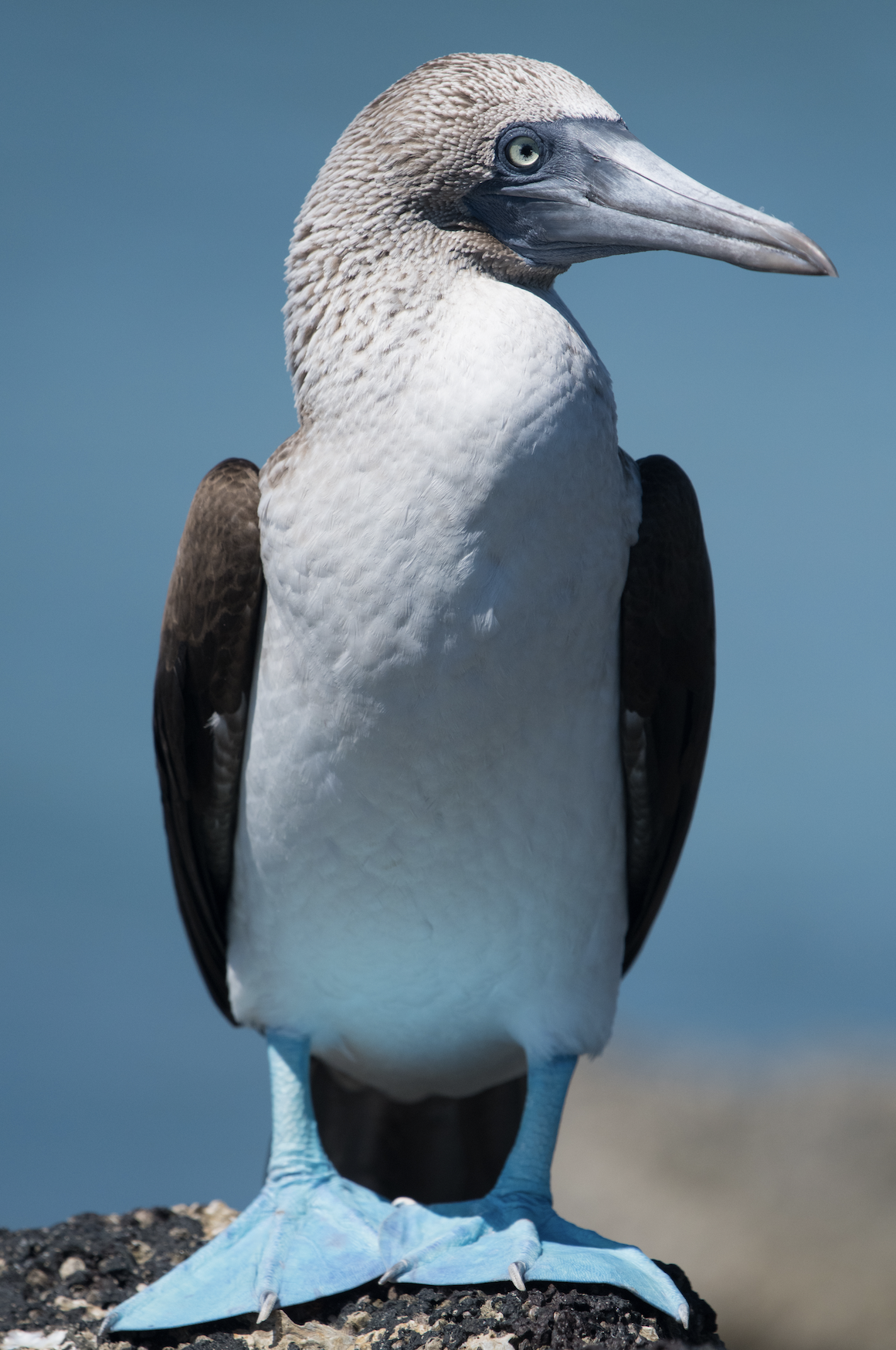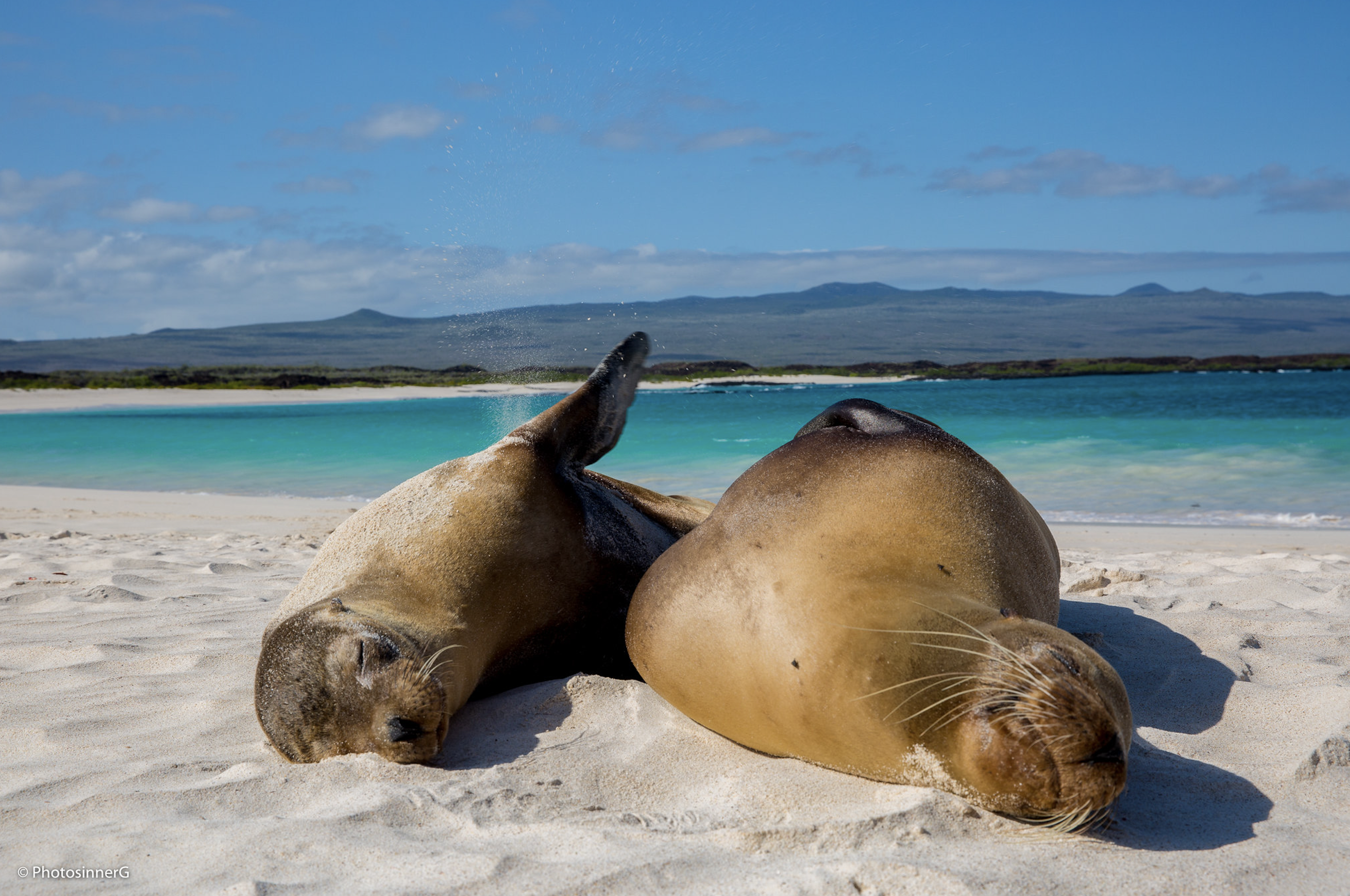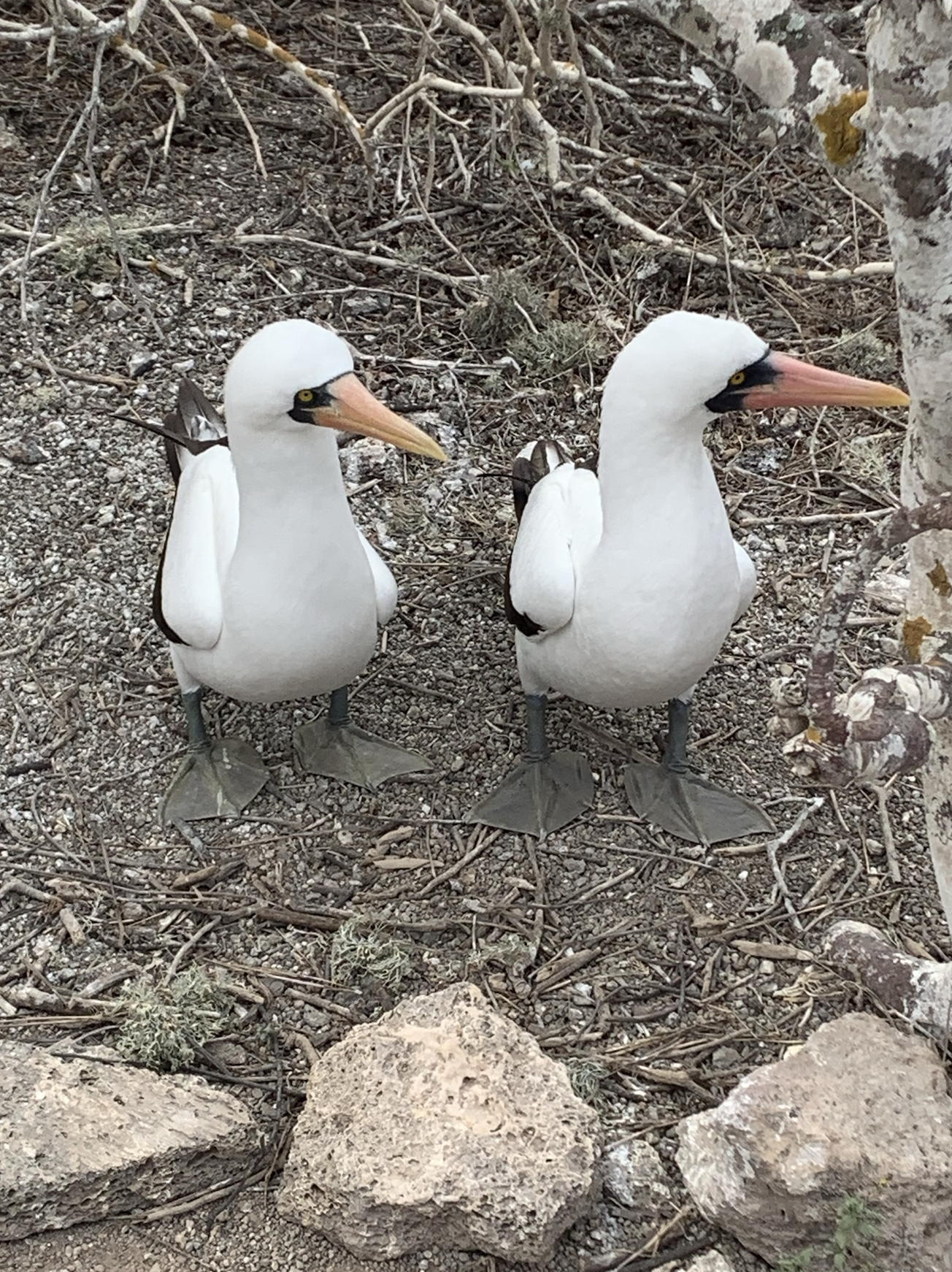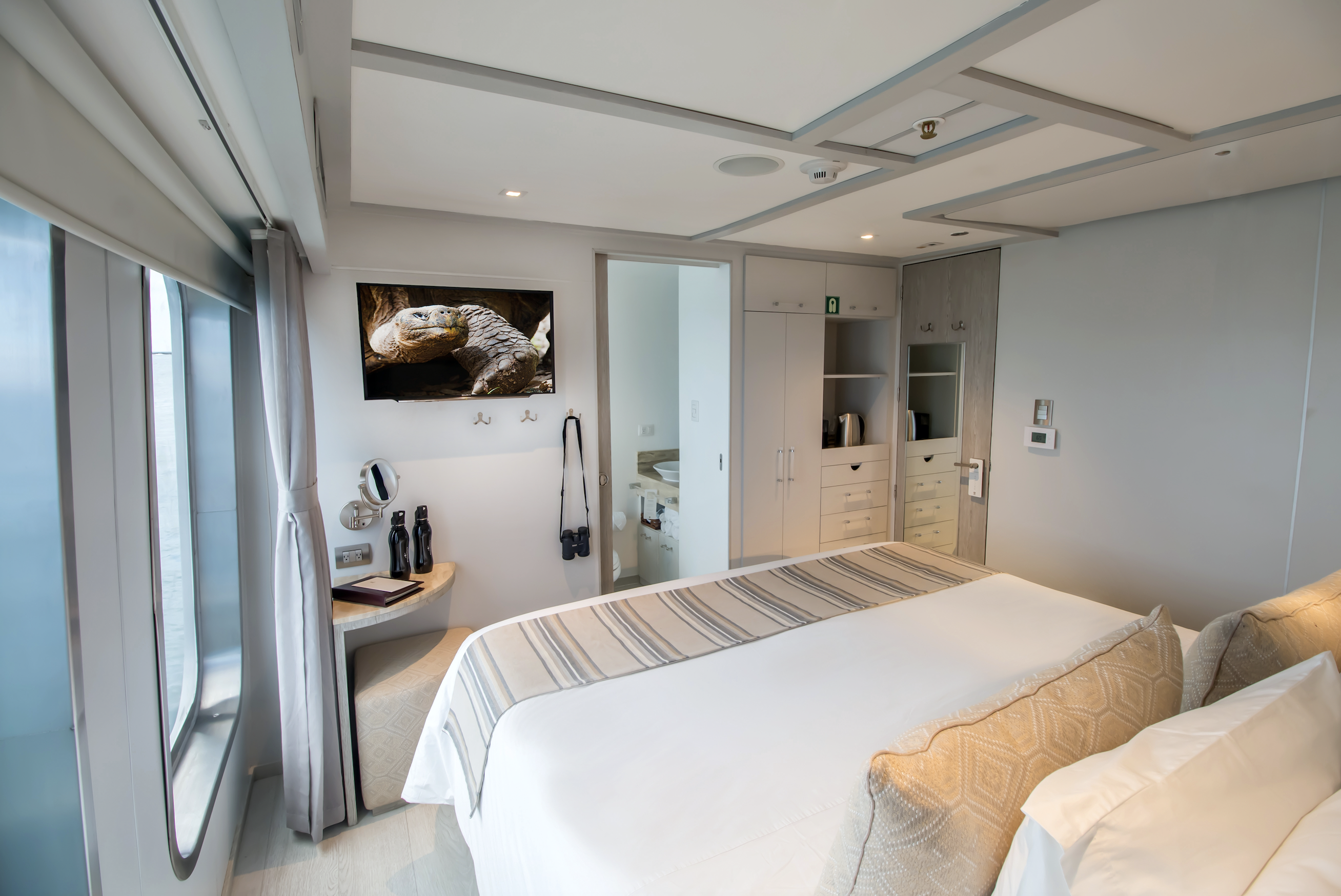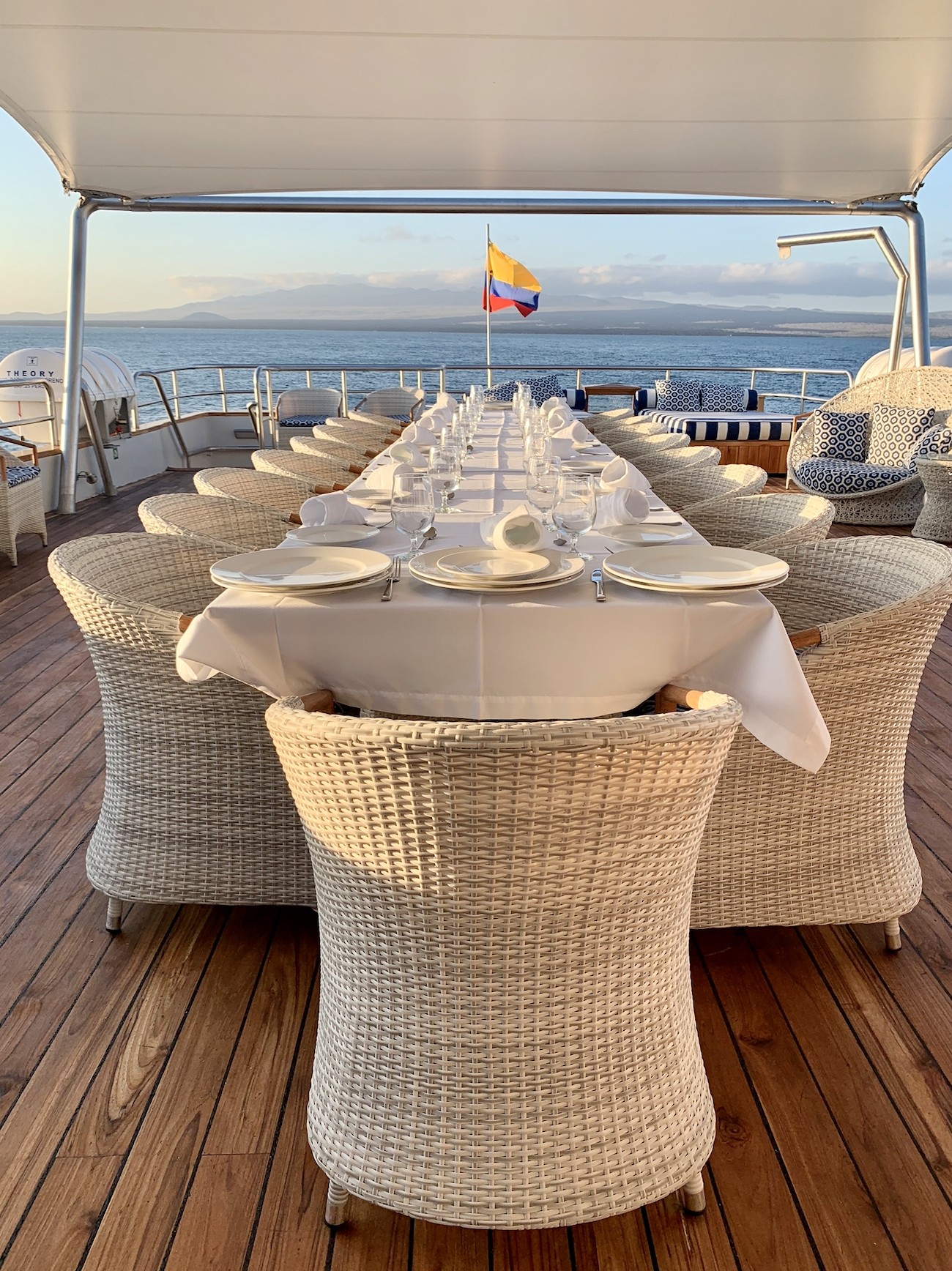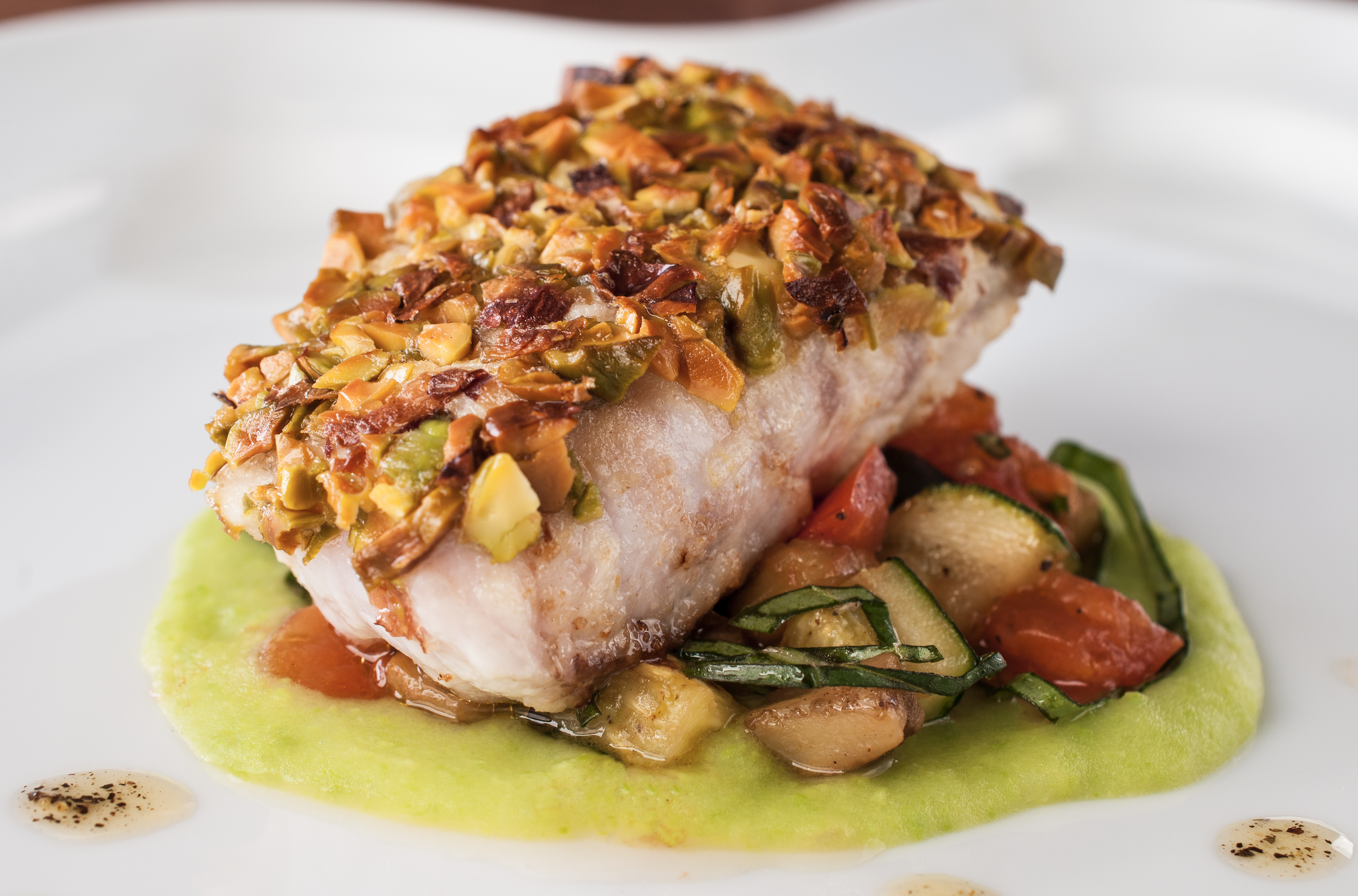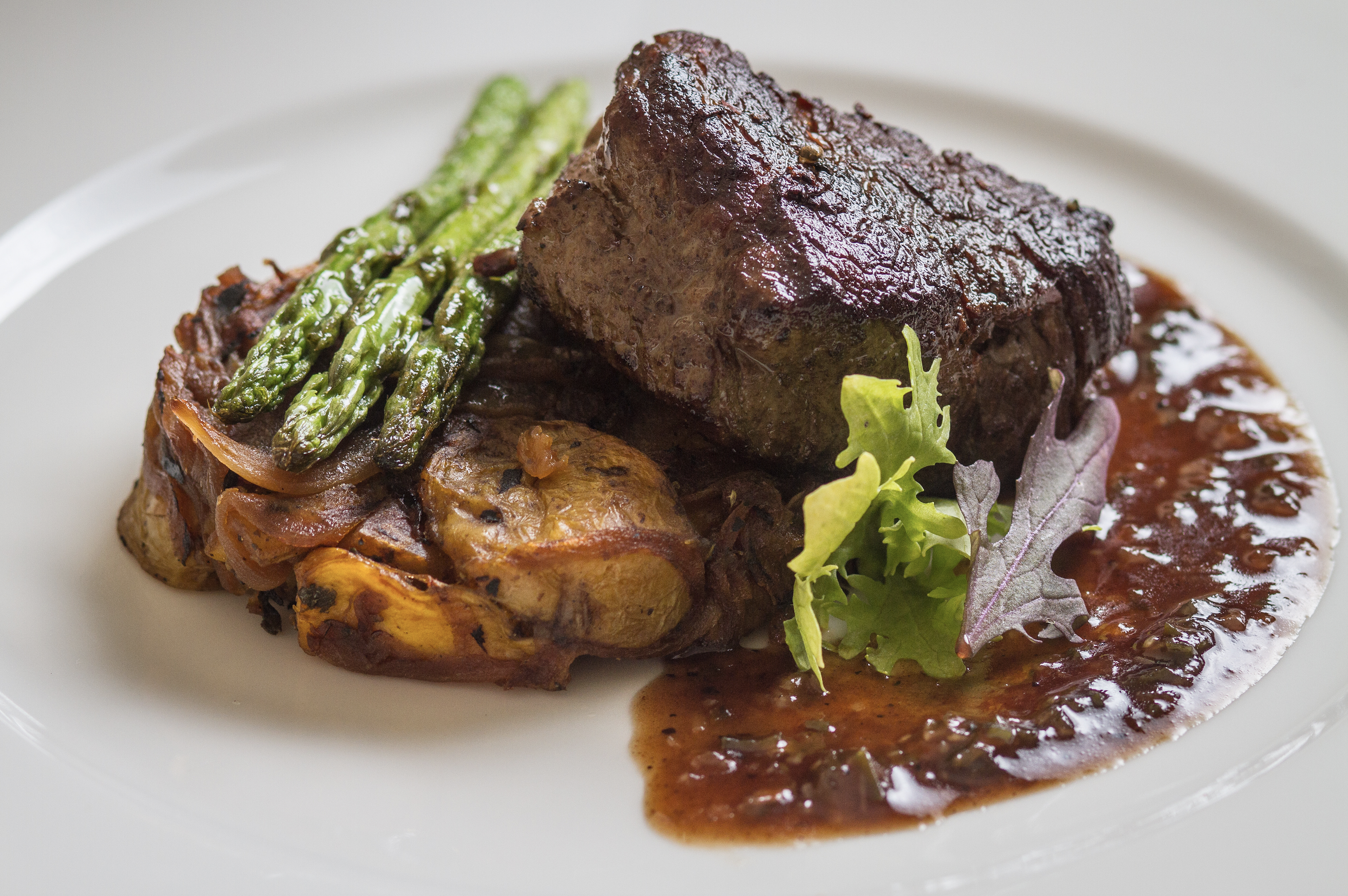Written by { Beth Weitzman
As someone who tends to get seasick, I was a bit apprehensive about spending seven nights and eight days on a boat. But Theory is not just any boat. It’s a 20-passenger luxury mega-yacht, one of only two such vessels to be named a Relais & Châteaux.
So at my friend’s urging, we booked a trip with Ecoventura, a company that leads eco-expeditions in the Galapagos Islands aboard Theory and its twin sister ship, Origin. The result? An absolutely five-star, once-in-a-lifetime experience. And thanks to the Scopolamine patch, even with occasional rockiness at night and in the dining room, I never felt sick.
In the Beginning
As is the case with many exotic destinations, it’s a bit of an ordeal to get to San Cristobal Island, the easternmost island in the Galapagos archipelago, which is the departure point for Origin and Theory. The only flights to the island are from Ecuador’s two major airports—Mariscal Sucre International Airport in Quito and José Joaquín de Olmedo International Airport in Guayaquil. My friend and I landed in Quito, the capital of Ecuador, two days before sailing. Although Ecoventura offers one complimentary night at an airport hotel, we chose to stay at Casa Gangotena, a Relais & Châteaux property in the city center.
We enjoyed walking around the town on our one full day there, then retreated to the hotel to relax over cocktails on the rooftop deck, followed by dinner in the main dining room. The hotel, staff and service were lovely.
The morning of embarkation, we flew from Quito to Puerto Baquerizo Moreno, on San Cristobal Island, aboard Avianca Airlines. Our flight had been booked and coordinated by Ecoventura, and check-in was a breeze. An Ecoventura representative met us and the other expedition guests in the departures area and ushered us directly to the gate. When we landed at the small airport on San Cristobal Island, we were met by our Ecoventura naturalist guides, Fernando and Sofia, who, along with the yacht’s 13 crew members, served as our very attentive and knowledgeable hosts for the week-long trip on the Pacific Ocean.
All Aboard
After a five-minute car ride from the airport, we arrived at the dock, where we spotted the first of the hundreds of sea lions we’d encounter on this trip, as well as bright red crabs crawling on the rocks, and we spent a few minutes taking it all in. From there, we took a motorized Zodiac inflatable boat to Theory, the newest yacht in the Ecoventura fleet. It’s a stunner—even more striking than it appears in photos.

In 2000, Ecoventura invested in making its luxury expedition yachts greener by installing solar panels to offset carbon emissions, and considerably reduced the use of plastics on board. As a result, Ecoventura was the first recipient of SmartVoyager ecological certification and is certified by Rainforest Alliance Best Practices. Theory and Origin are built with naval steel and designed to minimize environmental impact. Their curved bows cut through waves, providing for smooth sailing and less drag, and resulting in reduced fuel consumption. Fixed stabilizers reduce rolling and lessen the likelihood of seasickness.
We climbed aboard and went straight to the main dining room, where most of our meals were served (some meals were also served alfresco on the sundeck) at marble-top tables for two to 10 diners. With plenty of large windows, it’s a welcoming and cozy space in which to enjoy a locally inspired buffet lunch of Ecuadorian delights and sustainable seafood, with special emphasis on local shrimp, offered in various preparations during the trip.

After lunch, we attended a welcome briefing and short safety drill. Clearly, the Ecoventura team takes very seriously the safety of its passengers, as well as the protection of wildlife, islands and oceans.
Then we checked into our deluxe staterooms, which impressed me beyond my expectations. All 10 cabins are on the lower Beagle deck; two cabins have interconnecting doors, and two accommodate triples with a third pull-down bed. The modern-design rooms are light, bright and feel surprisingly spacious. Ours had two twin beds (which convert to a king for couples) separated by a nightstand with universal docking station, USB and plug charging, and clock. Beds have a memory-foam mattress and are dressed in fine linens, a comfy comforter and soft pillows. Two large windows (with retractable black-out curtains) provide expansive views of the water, morning to night. The modern bathroom features a nice-size rainfall shower, dual-flush toilet, single sink, plush towels, hair dryer, and biodegradable hand soap, body wash, shampoo and conditioner in dispensers. The sectional closet has drawers for folded clothing, as well as waffle bathrobes and slippers for use during the journey. There’s also a safety deposit box in which to keep valuables, and an espresso maker and tea kettle. A corner nook serves as a vanity with stool and lighted mirror, and next to that is a flat-screen TV with preloaded movies.

Away We Go
Each day, at least two excursions kept us busy without overwhelming us, and we did tons of wildlife viewing. Only one species, the waved albatross, migrates, so you really can’t go wrong no matter the time of year you go. Galapagos hawks, fur sea lions, penguins, marine iguanas, blue-footed boobies, flightless cormorants and more are seen any time of year. Despite the location near the equator, the Galapagos Islands offer a cool, subtropical island climate, nestled in the Pacific dry zone. June to December is known as the cooler, dry season, and December to May is the warm, wet season, when you can expect short but strong bouts of rain and warm, moderate temperatures.

In the Galapagos, you get to experience nature at its purest and most pristine. The islands—many inhabited only by animals—are highly protected and strictly managed, so as not to disturb the wildlife. The National Park Service gives each boat an itinerary, which must be strictly followed, and each spot we visited seemed like we had it all to ourselves. Rarely did we encounter another group touring the same site. Humans are required to stand a minimum of six feet away from the animals.
On our first afternoon, we took an excursion to La Galapaguera Cerro Colorado, a tortoise reserve on the southeast of San Cristobal, where we saw tortoises of all sizes and ages. Our guides explained their evolution and the threats posed by invasive species and habitat loss. The National Park’s breeding program was established to ensure that these endangered amphibians do not become extinct. Along the trail, we also spotted a San Cristobal mockingbird and Calandrinia plant, both native to the island.

Before setting sail, I hadn’t realized how much interaction we’d have with the guides. During casual conversations at meals, evening briefings and enrichment lectures, as well as on excursions, their knowledge was inspiring and their passion contagious.
Back on the yacht, we freshened up before a welcome reception with the captain and crew in the lounge area, adjacent to the bar. Without a doubt, this is a luxury experience, but casual attire is always on point. As they did each evening, the guides reviewed what we’d seen that day and previewed where we’d be traveling the next day. The briefing was always followed by a delicious three-course dinner. Open bar—cocktails, beer, red, white and sparkling wine—is included. Only super-premium wines or spirits are subject to an additional charge.
As we wined and dined, we sailed to Genovesa Island, otherwise known as bird island. The yacht travels mainly at night, at speeds of 12 to 14 knots, which facilitates maximum daytime exploration. The cuisine throughout the journey was very impressive—three-course dinners featuring super fresh seafood, meat and vegetarian options. After dinner, we wandered around the boat and checked out the small but mighty fitness center, which is equipped with a treadmill, elliptical, free weights and yoga mats; the boutique, which sells local handicrafts, sundries and gift items; and the library, with its selection of publications, some rare, dedicated to the Galapagos and Charles Darwin. We then retired to our stateroom for a quick email check (each room comes with one-device WiFi access; usage for additional devices is available at an extra charge) before heading to bed for a good night’s rest.
Each morning, a buffet breakfast is available any time prior to the excursion, which usually leaves around 8 a.m. We enjoyed our first wet landing via Zodiac at Darwin Bay, on a gorgeous coral sand beach, where we were awed by the array of birds, including red-footed boobies, swallow-tailed gulls and lava gulls. A forest of Opuntia cacti and mangroves provided a safe place for Great frigatebirds to perch; it’s a pretty cool sight when a male, looking to attract a mate, inflates a red pouch on his chest. On the beach, we were spellbound by a playful mama sea lion and baby, communicating in their own language. Our guides explained that it’s not uncommon for a mama to temporarily leave her baby on the shore while she goes searching for food. If she doesn’t return, another female typically will not offer assistance to the little one. Humans, even the naturalists, are prohibited from getting involved—all in the name of letting nature take its course.
We returned to the yacht, donned wet suits and grabbed snorkel gear. On a deep-water snorkeling experience, we saw a variety of brightly colored fish and sea turtles. The yacht supplies five double kayaks, one single kayak, two stand-up paddleboards, wet suits, masks, fins and snorkels and beach towels for guest use at no additional cost. There is also a glass-bottom Zodiac boat for guests who opt out of snorkeling at any given time during the sailing.

Lunch was a delicious BBQ, and the chef demonstrated how to make Ecuadorian ceviche on the yacht’s sundeck, where we relaxed after we ate. Featuring two double daybeds and three cocoon-style chaise lounges, seating at tables, a bar, six-person Jacuzzi and plenty of shade, the sundeck was my favorite spot on the yacht.
That afternoon, we had a dry landing at Prince Philip’s Steps, a steep path on Genovesa Island, known as one of the most spectacular places in Galapagos for bird-watching. Our guides pointed out red-footed boobies nesting in Palo Santo trees, Nazca boobies nesting right off the trail, and storm petrels. We also had the good fortune of seeing a rare short-eared owl.
The following day’s excursion was to Black Turtle Cove (Caleta Tortuga Negra), where we rode in the Zodiac through a series of beautiful coves and inlets surrounded by mangroves. We saw plenty of sea turtles, schools of white-tipped reef sharks and golden cow-nosed rays. Being so close to the animals was magnificent.
Lunch was another beautiful buffet aboard the yacht. Then we headed ashore to Dragon Hill (Cerro Dragon), to take in panoramic views of the bay and island landscape. We spotted a few flamingos in the lagoon and our guides pointed out a variety of tropical trees and vegetation. On a walking trail, we spotted Darwin’s finches, Galapagos flycatchers, and sandpipers, among others. We also encountered large yellow land iguanas, strikingly different from their marine cousins, resting in the sun. These iguanas, which are native to the Galapagos, were once part of the Station’s breeding program. Since the animals are protected and not bothered, they don’t bother humans, either. Then, we returned to the yacht for our evening briefing, dinner and some stargazing on the upper deck. The dark sky was filled with bright stars. Really beautiful.

Wednesday brought us to another geological wonder, Punta Espinoza on Fernandina Island, the youngest and least disturbed in Galapagos. Formed by active volcanoes along the coast, it’s considered one of the most pristine ecosystems, with all its wildlife indigenous. Even though we’d already seen many sea lions, we were still awed by the mama-and-baby interactions. We also saw loads of marine iguanas basking on the shore, their dark skin camouflaging them against rocks. Here, we also experienced the most epic snorkeling among sea lions and penguins; beneath us, iguanas were feeding along the bottom of the ocean. The memory will stay with me forever.
The afternoon excursion was to Urbina Bay on Isabela Island, where we saw the aftereffects of volcanic activity. We were wowed by a diverse collection of animal species, including Galapagos land iguanas, marine iguanas, Darwin’s finches, pelicans, flightless cormorants, and the occasional giant Galapagos tortoise. We explored for a while and returned to the vessel for the nightly briefing, drinks, dinner and after-dinner stargazing on the upper deck.
Later that night, we crossed the equator and arrived in Elizabeth Bay by the next morning. We hopped aboard a Zodiac, zipped through mangroves and saw more penguins, sea lions and an array of birds. We navigated to Tagus Cove, where pirates and whalers as early as the 1800s carved graffiti onto the rocky cliffs. We had the option of exploring the shoreline of the secluded cove by kayak or paddleboard to see more penguins, boobies, pelicans and other seabirds; or go for a fast-paced hike to a saltwater lagoon and scenic view of the ocean, lava fields and volcanic formations. While all of that sounded delightful, I opted to spend this time kicking back on a daybed on the upper deck with a cocktail in hand, observing the Great frigatebirds alongside the yacht.

That night, we crossed the equator for the third and final time as we sailed toward the geographic center of the archipelago. On Friday, we arrived to a wet landing in Puerto Egas on Santiago (a.k.a. James) Island, where we strolled along the shoreline, observing sea life swimming in tide pools and marine iguanas feeding on exposed green algae. During mating season, green and red algae give the typically black marine iguanas beautiful coloration of bright yellow and orange. The walk ended at the grottos—deep, clear pools of water, where we encountered fur sea lions, once on the verge of extinction. Before returning to the yacht, we snorkeled along the beach.
Our after-lunch excursion was to the surreal-looking, dark red beach of Rabida Island. A short trail led to a saltwater lagoon with a few flamingos. Again, we saw marine iguanas, mockingbirds and Darwin’s finches—and we remained in awe. Over one dozen species of finches live on the islands. As the story goes, observing them contributed to Charles Darwin’s ideas that formed the basis for his theory of evolution.
That evening for dinner, a large social dining table was set up on the sundeck and we enjoyed BBQ lobster, chicken and tuna, baked potato and veggies. Delish. After dinner, one of the guests and some of the staff played guitars, and the festivities soon turned into a fun, impromptu dance party.
On Saturday morning, we found ourselves among other boats anchored in the lively harbor of Academy Bay. We disembarked at Puerto Ayora, Santa Cruz Island, the social heart of the Galapagos (population: 24,000). We visited the breeding center Centro de Crianza Fausto Llerena and Charles Darwin Research Station, where we learned about conservation efforts and observed hatchlings and miniature tortoises that, when grown, will be repatriated by the National Park. The newest exhibit honors Lonesome George, the last Pinta Island tortoise, who tragically died in 2012. With his species now extinct, Lonesome George has become a worldwide icon, emphasizing the importance of efforts to preserve and protect endangered wildlife. We also learned about Diego, a saddleback tortoise whose species was minimized to a mere 14 individuals before he was transported to the Galapagos from the San Diego Zoo. He has since fathered hundreds of tortoises. Afterward, we strolled through town, where we sampled Ecuadorian chocolate ice cream and locally grown coffee, and shopped for handmade souvenirs.
As usual, we returned to the yacht for lunch and, again, I opted to relax on the sundeck while other guests took a short ride to a lava tunnel, then to Los Gemelos, a pair of large, deep craters with vibrant plant life. They also stopped at a privately owned hacienda, where giant tortoises—some weighing more than 500 pounds—roam freely in their natural habitat.
Our final dinner aboard was the most unforgettable of them all. The other guests and I, now good friends, reminisced about the amazing experiences we shared on and off Theory. The next day, we had a dry landing and visited the interpretation center beach, with sea lions everywhere, and we had lunch in town before heading to the airport. While the trip inevitably had to end, the memories we made will endure for all of us…forever. 800.633.7972, ecoventura.com





